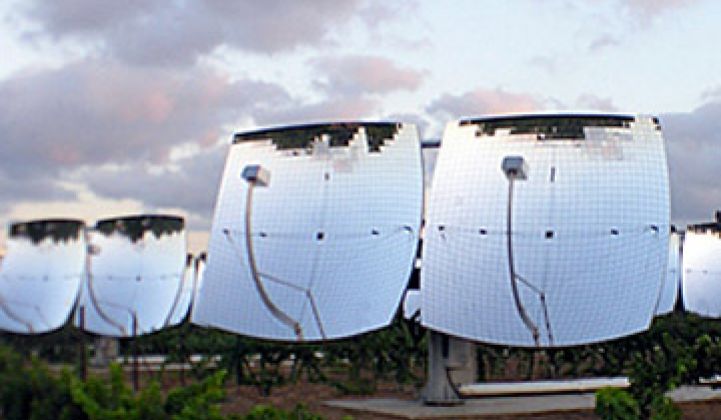Seder Boqer, Israel --- It’s like a concentrating solar PV system on growth hormones.
ZenithSolar has begun to tout a CPV/solar hot water system that it says will produce over 2 kilowatts of electricity and the equivalent of 5 kilowatts of solar hot water.
The system consists of a mirrored dish that concentrates the equivalent of 1,000 suns onto a III-V solar cell, according to David Faiman, director of the National Solar Energy Center and chair of the department of solar energy and environmental physics department at Ben-Gurion University here.
The high temperatures created by the solar dish necessitate cooling the solar cell with water instead of with passive metal heat sinks. The water is then run through heat exchangers to provide hot water to an industrial or commercial site.
So far, it sounds similar to technology from Cogenra, which has a CPV/solar hot water system based around silicon solar cells.
The big difference is that ZenithSolar does everything in Texas-sized dimensions. The concentrating dish covers around 11 square meters of area. The solar cell is not a tiny chip: It measures around 10 centimeters on each side.
“It may look like a Stirling engine but the technology is totally different,” Faiman said.
In June, the dish can produce around 250 gallons of hot water at 70 degrees Celsius a day. in January, it’s about half that.
The system is also easy to maintain. The cells sit on a modular frame and can be slid out. (Editor’s note: the larger size of the cell and tracker also potentially ease some of the problems with trying to track the sun with a medium-sized mirror and a small solar cell.) ZenithSolar typically will park two dishes together at a site.
The company will show off a system in Las Vegas on April 4. It has deals underway in Australia and China. A couple of the systems are running at a kibbutz in Israel.
Concentrators have been a zero-billion-dollar industry for some time, but optimism is in full bloom these days. Amonix, which makes a concentrating system built around lenses, recently signed PPAs with Southern California Edison for 28.5 megawatts worth of power. Soitec landed a 150-megawatt project. SolFocus is part of a 300-kilowatt plant in Saudi Arabia. SunPower, which started out in concentrating solar, announced last year that is has developed a concentrator that it will release in the next few years.
IS CPV cost-competitive? What is the reliability? Will banks support it? These questions remain unanswered, but the picture is a lot brighter than it was a year ago.
A portion of the intellectual property behind ZenithSolar, Amonix and SolFocus came from Faiman’s National Solar Energy Center, which basically consists of a few trailers converted to offices and a big demonstration field with thermal, CPV and PV experiments sponsored by the University and the private sector. (Video, and another story on an upcoming paper from Faiman, are coming soon.)
The CPV renaissance stems from a few factors. For one thing, CPV can help reduce some of the pain the solar industry faces when it comes to the price of passive raw materials. Racking, glass and other non-silicon costs can gobble up a large part of a solar installation budget. Solar modules account for around 50 percent of the cost of a solar system and about half of that total comes from glass and other module manufacturing costs. Balance-of-system costs can run another 40 percent.
“The [ZenithSolar] receiver only accounts for five percent of the cost of the system,” he said.
At the same time, the technology has improved, while crystalline silicon solar cells have begun to approach the efficiency ceiling. Concentrators further help power providers compensate for the relatively un-dense nature of solar energy. Over the course of a year, a square meter of earth will receive the equivalent of a barrel of oil worth of energy from the sun. Humans use the equivalent of 230 million barrels of oil of energy a day, he said. (Actual oil consumption comes to around 81 million barrels of oil a day, but oil accounts for only one-third of our energy.)
“The sun is one of the weakest forms of energy we know,” said Faiman.
Despite his enthusiasm for CPV, Faiman says he is also rooting for thin films and solar thermal. CPV works optimally in hot, isolated areas without much cloud cover. CPV will also require storage. If clouds pass over a standard PV system, power output dims. If clouds pass over a CPV field, the power going to a utility could take a drastic dip.
“If CPV were the only solution, we’d have to cover the deserts and build big transmission lines,” he said.



